2014 CHRYSLER 300 SRT check transmission fluid
[x] Cancel search: check transmission fluidPage 102 of 590
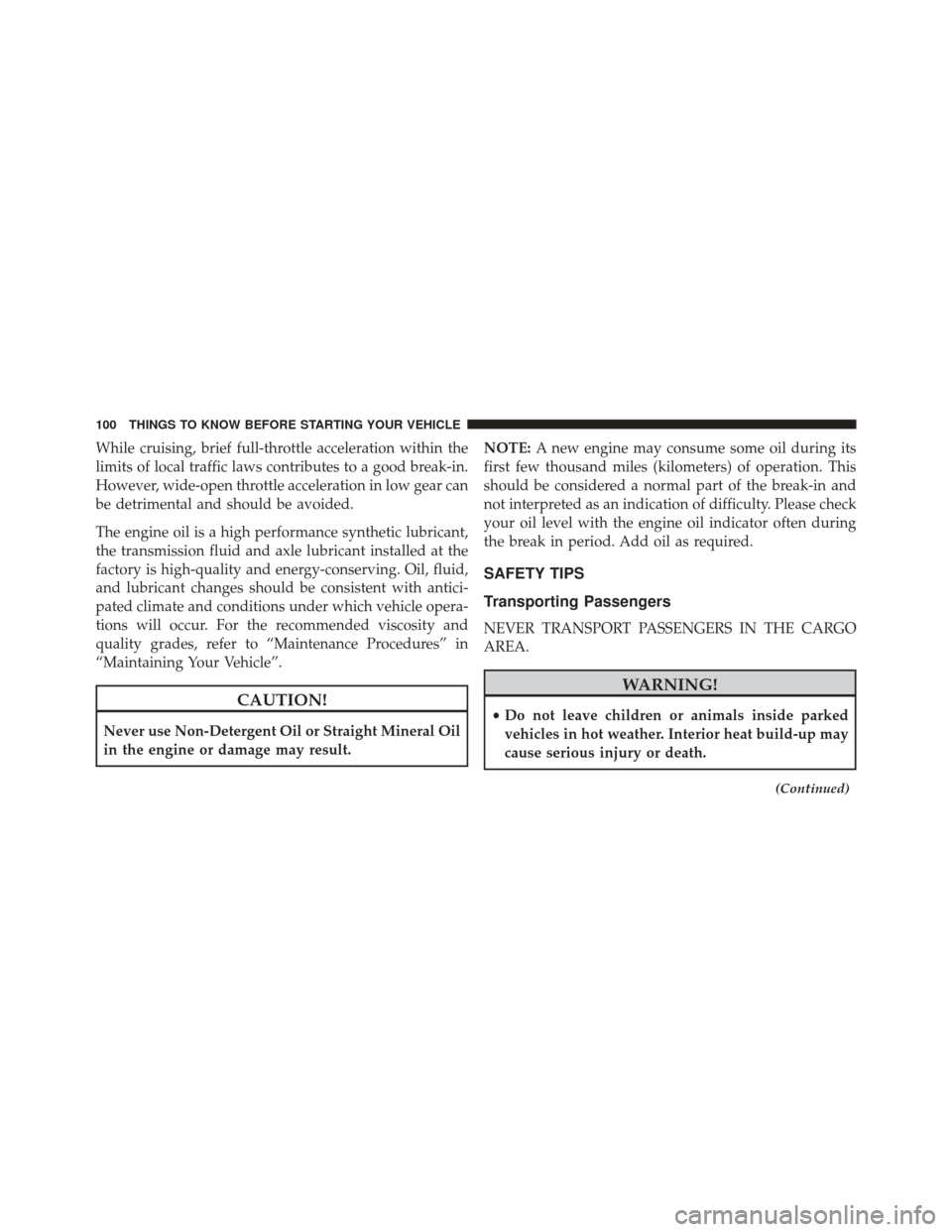
While cruising, brief full-throttle acceleration within the
limits of local traffic laws contributes to a good break-in.
However, wide-open throttle acceleration in low gear can
be detrimental and should be avoided.
The engine oil is a high performance synthetic lubricant,
the transmission fluid and axle lubricant installed at the
factory is high-quality and energy-conserving. Oil, fluid,
and lubricant changes should be consistent with antici-
pated climate and conditions under which vehicle opera-
tions will occur. For the recommended viscosity and
quality grades, refer to “Maintenance Procedures” in
“Maintaining Your Vehicle”.
CAUTION!
Never use Non-Detergent Oil or Straight Mineral Oil
in the engine or damage may result.NOTE:
A new engine may consume some oil during its
first few thousand miles (kilometers) of operation. This
should be considered a normal part of the break-in and
not interpreted as an indication of difficulty. Please check
your oil level with the engine oil indicator often during
the break in period. Add oil as required.
SAFETY TIPS
Transporting Passengers
NEVER TRANSPORT PASSENGERS IN THE CARGO
AREA.
WARNING!
• Do not leave children or animals inside parked
vehicles in hot weather. Interior heat build-up may
cause serious injury or death.
(Continued)
100 THINGS TO KNOW BEFORE STARTING YOUR VEHICLE
Page 469 of 590
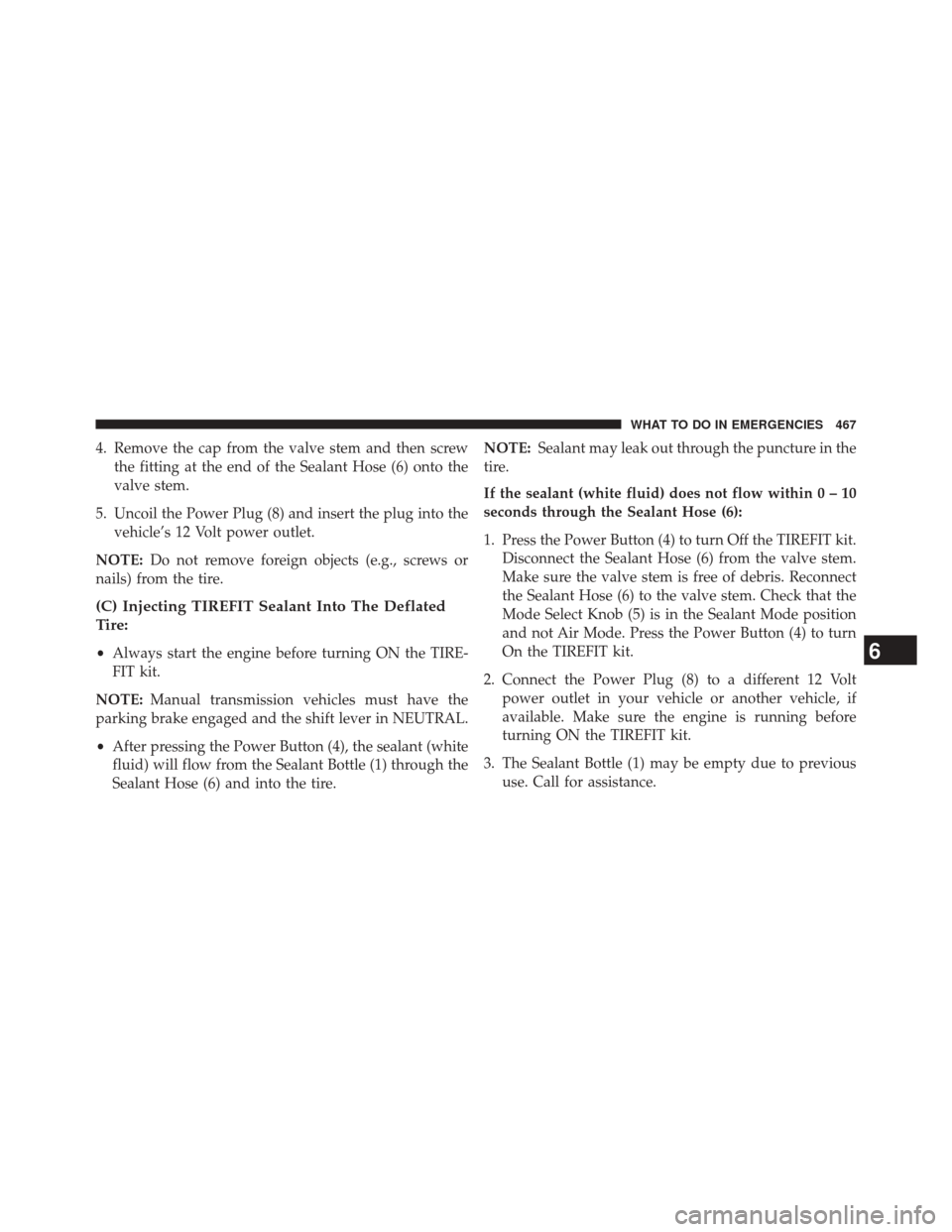
4. Remove the cap from the valve stem and then screwthe fitting at the end of the Sealant Hose (6) onto the
valve stem.
5. Uncoil the Power Plug (8) and insert the plug into the vehicle’s 12 Volt power outlet.
NOTE: Do not remove foreign objects (e.g., screws or
nails) from the tire.
(C) Injecting TIREFIT Sealant Into The Deflated
Tire:
• Always start the engine before turning ON the TIRE-
FIT kit.
NOTE: Manual transmission vehicles must have the
parking brake engaged and the shift lever in NEUTRAL.
• After pressing the Power Button (4), the sealant (white
fluid) will flow from the Sealant Bottle (1) through the
Sealant Hose (6) and into the tire. NOTE:
Sealant may leak out through the puncture in the
tire.
If the sealant (white fluid) does not flow within0–10
seconds through the Sealant Hose (6):
1. Press the Power Button (4) to turn Off the TIREFIT kit. Disconnect the Sealant Hose (6) from the valve stem.
Make sure the valve stem is free of debris. Reconnect
the Sealant Hose (6) to the valve stem. Check that the
Mode Select Knob (5) is in the Sealant Mode position
and not Air Mode. Press the Power Button (4) to turn
On the TIREFIT kit.
2. Connect the Power Plug (8) to a different 12 Volt power outlet in your vehicle or another vehicle, if
available. Make sure the engine is running before
turning ON the TIREFIT kit.
3. The Sealant Bottle (1) may be empty due to previous use. Call for assistance.6
WHAT TO DO IN EMERGENCIES 467
Page 489 of 590
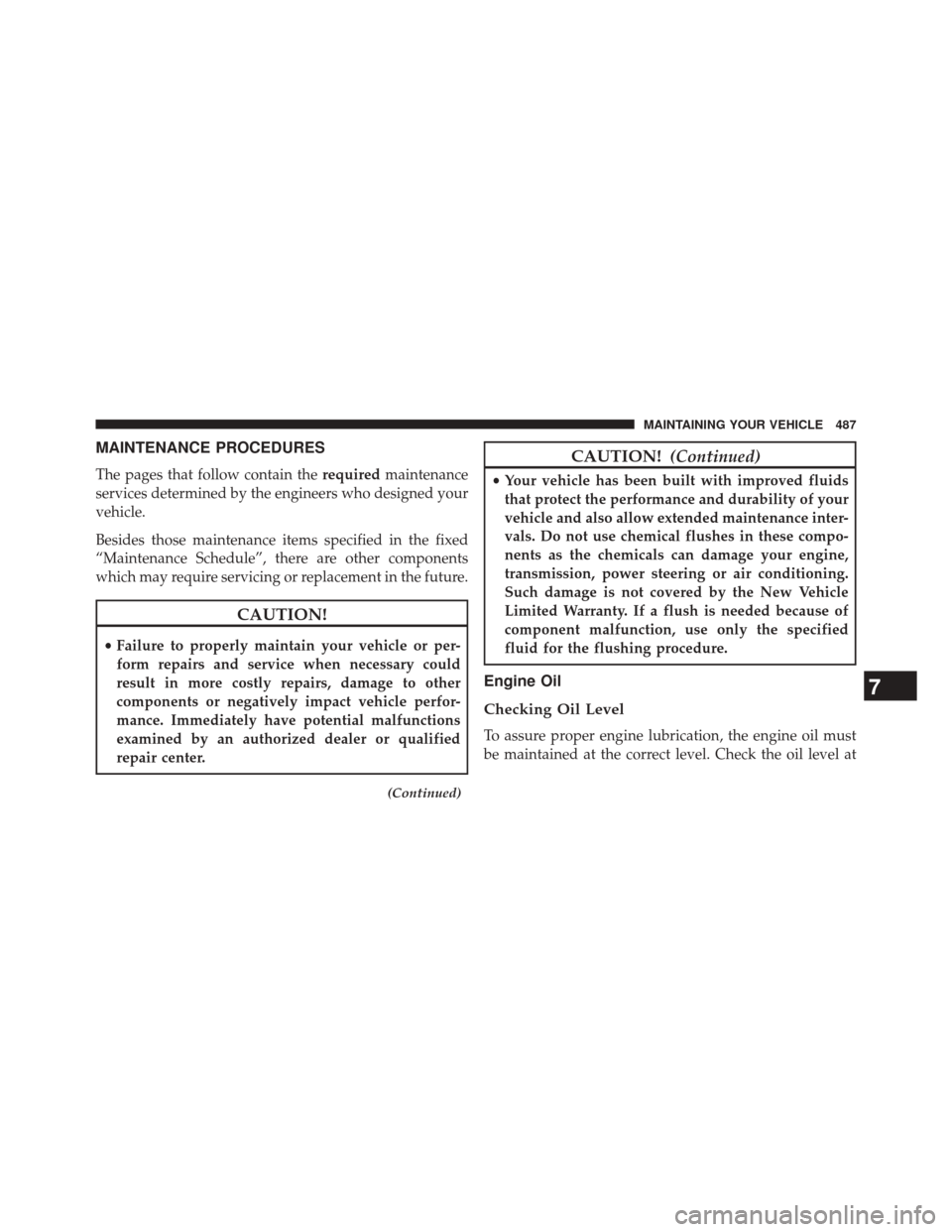
MAINTENANCE PROCEDURES
The pages that follow contain therequiredmaintenance
services determined by the engineers who designed your
vehicle.
Besides those maintenance items specified in the fixed
“Maintenance Schedule”, there are other components
which may require servicing or replacement in the future.
CAUTION!
• Failure to properly maintain your vehicle or per-
form repairs and service when necessary could
result in more costly repairs, damage to other
components or negatively impact vehicle perfor-
mance. Immediately have potential malfunctions
examined by an authorized dealer or qualified
repair center.
(Continued)
CAUTION! (Continued)
•Your vehicle has been built with improved fluids
that protect the performance and durability of your
vehicle and also allow extended maintenance inter-
vals. Do not use chemical flushes in these compo-
nents as the chemicals can damage your engine,
transmission, power steering or air conditioning.
Such damage is not covered by the New Vehicle
Limited Warranty. If a flush is needed because of
component malfunction, use only the specified
fluid for the flushing procedure.
Engine Oil
Checking Oil Level
To assure proper engine lubrication, the engine oil must
be maintained at the correct level. Check the oil level at
7
MAINTAINING YOUR VEHICLE 487
Page 511 of 590

recommended fluid. No chemical flushes should be used
in any transmission; only the approved lubricant should
be used.
CAUTION!
Using a transmission fluid other than the manufac-
turer ’s recommended fluid may cause deterioration
in transmission shift quality and/or torque converter
shudder, and will require more frequent fluid and
filter changes. Refer to “Fluids, Lubricants, and
Genuine Parts” in this section for fluid specifica-
tions.
Special Additives
The manufacturer strongly recommends against using
any special additives in the transmission.Automatic Transmission Fluid (ATF) is an engineered
product and its performance may be impaired by supple-
mental additives. Therefore, do not add any fluid addi-
tives to the transmission. The only exception to this
policy is the use of special dyes for diagnosing fluid
leaks. Avoid using transmission sealers as they may
adversely affect seals.
CAUTION!
Do not use chemical flushes in your transmission as
the chemicals can damage your transmission compo-
nents. Such damage is not covered by the New
Vehicle Limited Warranty.
Fluid Level Check
The fluid level is preset at the factory and does not
require adjustment under normal operating conditions.
Routine fluid level checks are not required, therefore the
7
MAINTAINING YOUR VEHICLE 509
Page 512 of 590
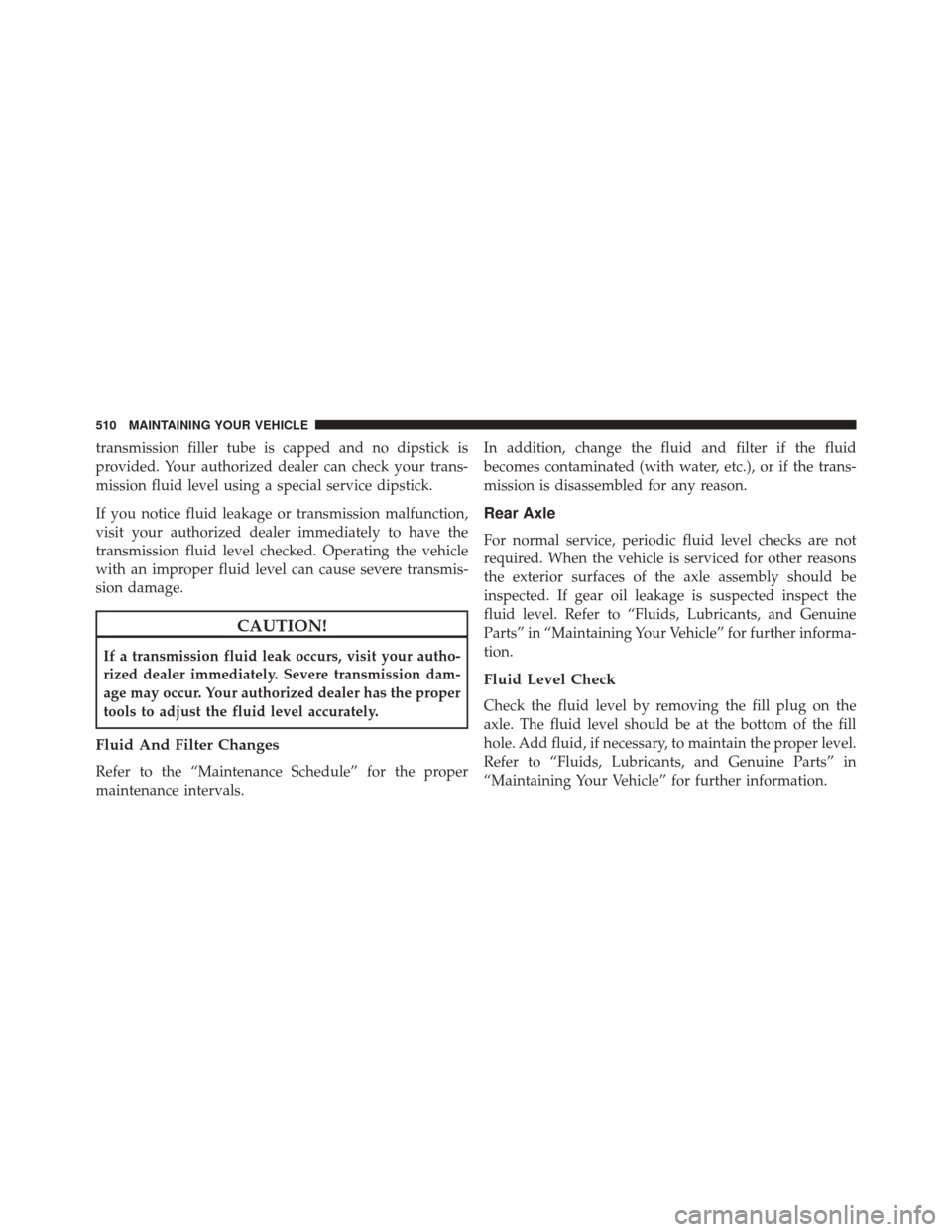
transmission filler tube is capped and no dipstick is
provided. Your authorized dealer can check your trans-
mission fluid level using a special service dipstick.
If you notice fluid leakage or transmission malfunction,
visit your authorized dealer immediately to have the
transmission fluid level checked. Operating the vehicle
with an improper fluid level can cause severe transmis-
sion damage.
CAUTION!
If a transmission fluid leak occurs, visit your autho-
rized dealer immediately. Severe transmission dam-
age may occur. Your authorized dealer has the proper
tools to adjust the fluid level accurately.
Fluid And Filter Changes
Refer to the “Maintenance Schedule” for the proper
maintenance intervals.In addition, change the fluid and filter if the fluid
becomes contaminated (with water, etc.), or if the trans-
mission is disassembled for any reason.
Rear Axle
For normal service, periodic fluid level checks are not
required. When the vehicle is serviced for other reasons
the exterior surfaces of the axle assembly should be
inspected. If gear oil leakage is suspected inspect the
fluid level. Refer to “Fluids, Lubricants, and Genuine
Parts” in “Maintaining Your Vehicle” for further informa-
tion.
Fluid Level Check
Check the fluid level by removing the fill plug on the
axle. The fluid level should be at the bottom of the fill
hole. Add fluid, if necessary, to maintain the proper level.
Refer to “Fluids, Lubricants, and Genuine Parts” in
“Maintaining Your Vehicle” for further information.
510 MAINTAINING YOUR VEHICLE
Page 569 of 590

Automatic Oil Change Indicator...............323
Automatic Temperature Control (ATC) ..........362
Automatic Transmission ....................379
Adding Fluid ......................... .510
Fluid and Filter Changes ..................510
Fluid Change ......................... .510
Fluid Level Check ...................... .508
Fluid Type ........................... .536
Special Additives ...................... .509
Auto Unlock, Doors ........................32
Auto Up Power Windows ....................40
Axle Fluid ............................. .536
Axle Lubrication (Axle Fluid) .................536
Battery ................................ .490
Keyless Transmitter Replacement (RKE) ........24
Location ............................. .490
Remote Battery Replacement ................24
Transmitter Battery Replacement .............24Belts, Seat
...............................49
Bluetooth® Connecting To A Particular Mobile Phone Or Audio
Device After Pairing .....................136
Connect Or Disconnect Link Between the
Uconnect® Phone And Mobile Phone .........152
Body Mechanism Lubrication .................495
B-Pillar Location ......................... .418
Brake Assist System ...................... .403
Brake Control System, Electronic ..............402
Brake Fluid ............................ .536
Brake, Parking .......................... .397
Brake System ........................... .506
Anti-Lock (ABS) ....................... .400
Fluid Check .......................... .506
Master Cylinder ....................... .506
Parking ............................. .397
Warning Light ........................ .309
Brake/Transmission Interlock .................379
10
INDEX 567
Page 574 of 590
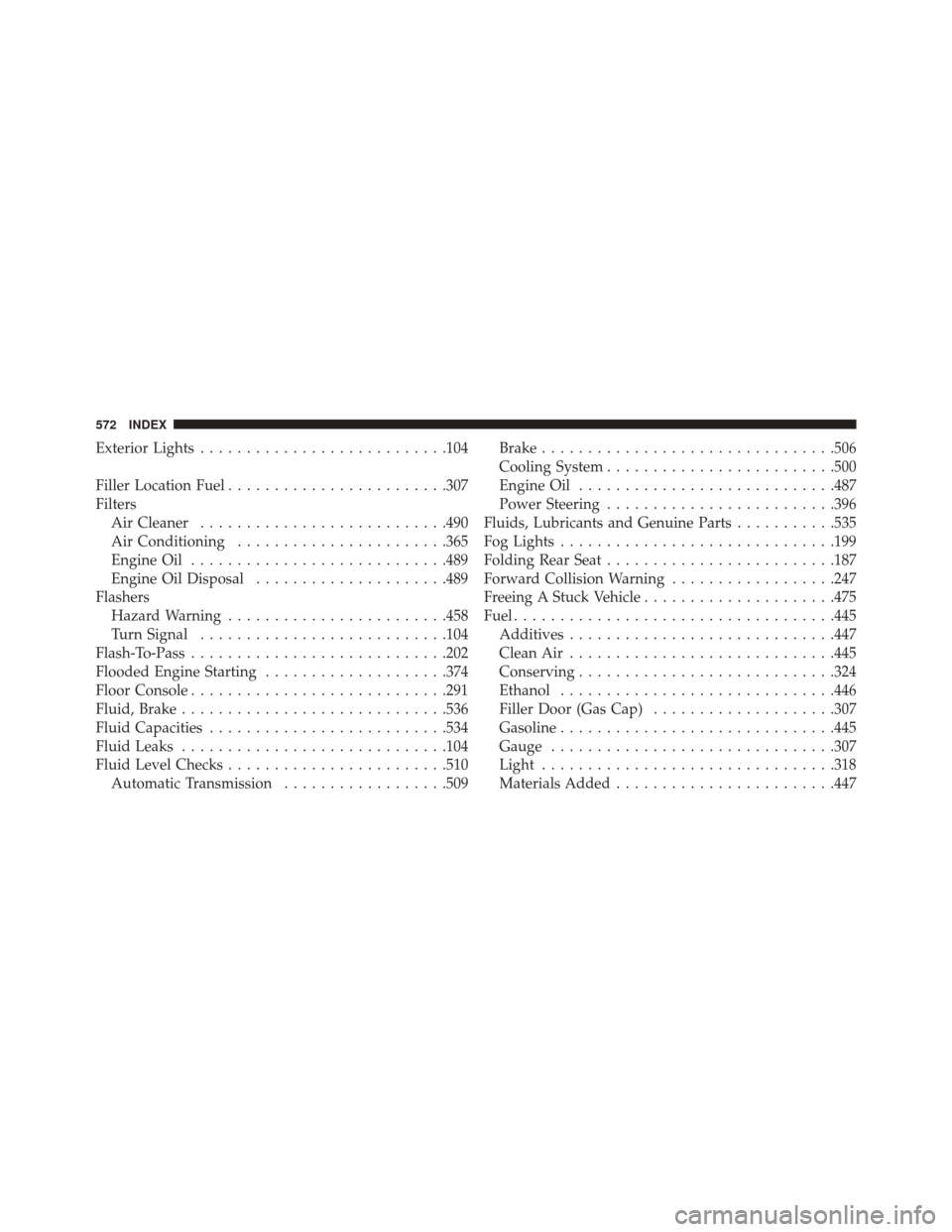
Exterior Lights.......................... .104
Filler Location Fuel ....................... .307
Filters Air Cleaner .......................... .490
Air Conditioning ...................... .365
Engine Oil ........................... .489
Engine Oil Disposal .....................489
Flashers Hazard Warning ....................... .458
Turn Signal .......................... .104
Flash-To-Pass ........................... .202
Flooded Engine Starting ....................374
Floor Console ........................... .291
Fluid, Brake ............................ .536
Fluid Capacities ......................... .534
Fluid Leaks ............................ .104
Fluid Level Checks ....................... .510
Automatic Transmission ..................509 Brake
............................... .506
Cooling System ........................ .500
Engine Oil ........................... .487
Power Steering ........................ .396
Fluids, Lubricants and Genuine Parts ...........535
Fog Lights ............................. .199
Folding Rear Seat ........................ .187
Forward Collision Warning ..................247
Freeing A Stuck Vehicle .....................475
Fuel .................................. .445
Additives ............................ .447
Clean Air ............................ .445
Conserving ........................... .324
Ethanol ............................. .446
Filler Door (Gas Cap) ....................307
Gasoline ............................. .445
Gauge .............................. .307
Light ............................... .318
Materials
Added....................... .447
572 INDEX